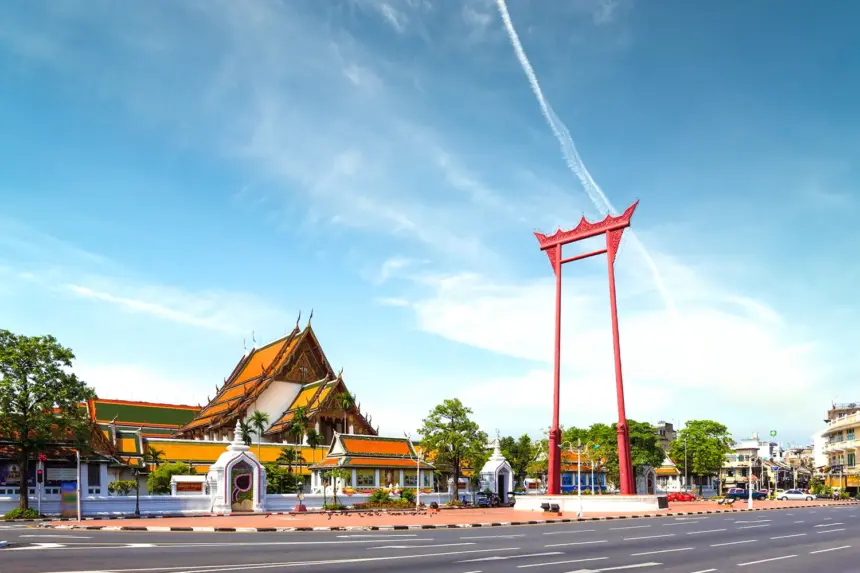Giant Swing: Sao Chingcha – A Cultural Landmark in Bangkok
The Giant Swing, or Sao Ching Cha, is one of Bangkok’s most iconic and historic landmarks, standing proudly in front of the towering Wat Suthat Thepwararam temple. Located in the heart of Thailand’s bustling capital, the Giant Swing has played a central role in Thai culture for centuries, symbolizing spirituality, ritual significance, and religious devotion. Its striking red pillars and enormous size make it a distinctive feature in the cityscape, but its importance goes far beyond its visual appeal.
In this article, we will delve into the history, religious significance, architectural beauty, and cultural importance of the Giant Swing, exploring why it remains one of the most fascinating symbols of Bangkok.
A Historical Overview of the Giant Swing
The Giant Swing, or Sao Ching Cha, was originally constructed in 1784 during the reign of King Rama I, the founder of the Chakri dynasty. This period marked the establishment of Bangkok as Thailand’s capital, and many religious and cultural landmarks were created to solidify the city’s status. The Giant Swing was one of these iconic structures, built to be a focal point for an ancient Brahmin ceremony known as the Triyampawai Ceremony.
The Giant Swing was initially used as part of this important religious festival, which honored Shiva, one of the principal deities in Hinduism. Despite Thailand’s strong Buddhist majority, Hinduism and Brahminism have deep historical roots in Thai culture, especially in royal ceremonies. Over the years, the Giant Swing has come to symbolize this intersection of spiritual traditions in Thailand, blending Hindu rituals with Buddhist practices.
Though the Giant Swing was actively used in religious ceremonies for several decades, it was retired from its ceremonial role in 1935 due to safety concerns. Since then, the swing has been maintained as a cultural monument, standing as a reminder of the rich history and religious heritage of Bangkok.
The Religious and Cultural Significance of Sao Ching Cha
The Giant Swing played a pivotal role in the Triyampawai Ceremony, an annual Brahmin festival held in honor of Shiva. This ceremony was connected to the Brahmanic New Year, and the Giant Swing was used as part of a dramatic ritual meant to symbolize the mythical Mount Meru, which in Hindu cosmology is considered the center of the universe.
During the ceremony, young Brahmin men would swing on the Giant Swing, soaring up to a height of 25 meters in an attempt to grab a bag of coins placed atop a pole. This act symbolized the journey of seeking Shiva’s favor and reenacted an ancient myth in which Shiva descended from the heavens to bless the Earth. The swing’s motion, with its skyward reach, was said to represent the endless cycle of life and death and the relationship between humanity and the divine.
The ritual was not only a religious one but also a test of bravery, as the swing was suspended at a great height, making it a perilous task for participants. Unfortunately, the risks associated with the ceremony eventually led to several fatalities, which resulted in the discontinuation of the use of the Giant Swing for religious purposes in 1935. Despite this, the symbolic importance of the Giant Swing remains deeply embedded in Thai culture, and it continues to be a place of reverence and spiritual contemplation.
Architectural Design and Structure of the Giant Swing
One of the most striking aspects of the Giant Swing is its immense size and architectural elegance. The structure stands at an impressive height of 21.15 meters (approximately 70 feet) and is made from two massive teakwood pillars. These pillars are painted in a vibrant red color, which adds to the grandeur and prominence of the swing, making it visible from afar. The simplicity of its design, combined with its scale, creates a powerful visual impact.
The top of the Giant Swing is capped with a crossbeam, creating a T-shaped structure that towers over the surrounding area. The clean lines of the pillars and crossbeam are reflective of traditional Thai architectural style, which often incorporates minimalist elements with a strong emphasis on symmetry and proportion.
The current Giant Swing is actually a replacement for the original, which deteriorated over time due to weather exposure and the effects of age. In 2005, the Thai government undertook a restoration project to preserve the integrity of the monument. The original teakwood structure, having stood for over two centuries, was replaced with new teak pillars sourced from Phrae Province in northern Thailand. This restoration project was completed in 2007, ensuring that the Giant Swing continues to stand as a symbol of Bangkok’s cultural and architectural heritage.
Wat Suthat and the Surrounding Area
The Giant Swing is located in front of Wat Suthat Thepwararam, one of Bangkok’s most revered and historically significant temples. Wat Suthat was commissioned by King Rama I and completed under King Rama III, taking nearly 40 years to finish. The temple is famous for its enormous ordination hall, intricate murals, and the Phra Si Sakyamuni, a massive bronze Buddha statue that stands as one of the largest in Thailand.
The proximity of the Giant Swing to Wat Suthat highlights the interconnection between the swing’s religious significance and the spiritual atmosphere of the temple. For visitors, this area offers a serene escape from the hustle and bustle of Bangkok, allowing them to experience the contemplative beauty of Thai Buddhism alongside the historic significance of the Giant Swing.
Wat Suthat’s expansive courtyard and architectural features provide a perfect backdrop for the Giant Swing. Many visitors choose to explore both the temple and the swing in one visit, gaining a deeper appreciation for Thailand’s intricate blend of religious traditions.
The Giant Swing in Modern Times
Today, the Giant Swing remains one of Bangkok’s most visited landmarks, drawing both locals and international tourists. While the swing is no longer used for ceremonial purposes, it continues to be a place of cultural importance. The annual Royal Brahmin Ceremony, which is performed by royal court Brahmins, still takes place in the vicinity of the Giant Swing, reflecting its ongoing connection to ancient traditions.
The Giant Swing has also become a symbol of Bangkok itself, representing the city’s deep ties to its spiritual roots while simultaneously embracing its modern identity. The monument is frequently featured in tourist promotions and guidebooks, solidifying its place as one of the must-see attractions in the city.
In addition to its cultural and religious significance, the Giant Swing is also an important site for photography and urban exploration. Its bold red color and towering presence against the backdrop of Wat Suthat create a striking contrast, making it a favorite spot for photographers looking to capture the essence of Bangkok’s historic architecture.
Visiting the Giant Swing
For visitors to Bangkok, the Giant Swing is a must-see attraction that offers insight into the city’s rich religious and cultural heritage. The site is easily accessible from many of Bangkok’s popular tourist areas, and its location near other landmarks, such as the Grand Palace and Wat Phra Kaew, makes it a convenient addition to any sightseeing itinerary.
Best Time to Visit: The Giant Swing can be visited at any time of the day, but early morning or late afternoon are often the best times to avoid the heat and crowds. These times also offer the best lighting for photography, as the soft sunlight enhances the color of the swing and its surroundings.
How to Get There: The Giant Swing is located in Phra Nakhon, the historic center of Bangkok. Visitors can take a taxi, tuk-tuk, or use the public transportation system to reach the site. The nearest BTS Skytrain station is National Stadium, from where you can take a short taxi ride to the swing.
Admission: There is no admission fee to see the Giant Swing, and visitors are free to explore the area at their leisure. If you wish to visit Wat Suthat, a small entrance fee is required to enter the temple complex.
Conclusion: A Monument of Cultural Significance
The Giant Swing, or Sao Ching Cha, stands as a testament to Bangkok’s rich cultural and religious history. Its towering red structure not only symbolizes an ancient Brahmin ceremony but also represents the city’s enduring connection to its spiritual roots. As one of Bangkok’s most iconic landmarks, the Giant Swing offers visitors a glimpse into the fusion of Hindu and Buddhist traditions that have shaped Thailand’s cultural landscape.
Whether you’re a history buff, a spiritual seeker, or simply a traveler exploring Bangkok’s many attractions, the Giant Swing is a place of both contemplation and awe. Its timeless beauty and cultural significance make it an essential part of any visit to the heart of Thailand.









